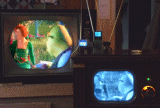Television Field Strength Meter (1955)


Have you ever bought a piece of test equipment just because it
looked cool? When I saw this TV field strength meter for a few
bucks at a swap meet, I brought it home, even though I had no
practical use for it at the time. Look at the size of that dial!
Its purpose is pretty obvious. You connect a TV antenna
to the front terminals and tune in a channel, then get
a reading of signal strength in tenths of a microvolt.

These meters were used while installing a rooftop TV antenna at
a customer's house. With a long extension cord, you could haul it up
on the roof to point the antenna correctly. If the antenna had a
motorized rotator, you could use the meter in the house to
show the customer where to point the antenna for best reception
on each channel.
The meter is basically a VHF television tuner with an amplifier to
drive the voltmeter. It uses a transformer type power supply
and six tubes. Like good quality TVs of the 1950s, it has
a robust turret type tuner. I'm just guessing about when it was
made, but the design and construction are consistent with the
mid-1950s.

Several years after I bought it, TV broadcasts were converted to digital
and I set up a home transmitter to broadcast
analog TV within our house. This photo shows a few of my TVs receiving a
home broadcast through their antennas.

Suddenly, I had a use for the meter! I restored it just as you would
a vintage radio, replacing old paper and electrolytic capacitors and
cleaning the tuner contacts.
I have no way to calibrate the meter, but it seems to work.
Close to my in-home transmitter, I get a reading of about eight-tenths
of a microvolt. Farther away in the house, it drops to about seven tenths.
This matches unscientific tests using a handheld TV like my
Sony Watchman or
Panasonic Travelvision.
Reception is best near the transmitter, and slightly weaker, although
still very watchable, as you move farther away.
Naturally, just as in the days of analog TV transmissions, the
orientation of both antennas—transmitter and receiver—has
a strong effect on reception. The signal quickly drops away to nothing
if you leave the house, and we live on three acres, so there's no
danger of interfering with neighbors' reception—even if
there were broadcasts to receive.
|